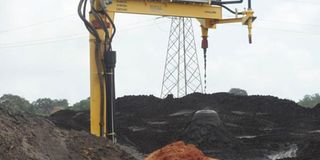Major weaknesses stand out for mineral sector

A titanium mining base in Kwale County. PHOTO | FILE | NATION MEDIA GROUP
What you need to know:
While revenues from the sector grew 2.1 per cent to Sh23.8 billion last year, according to the 2018 economic survey, the potential is still far from being fully exploited.
The delayed mineral mapping plan which is expected to demarcate which mineral is found where and in what quantity has been a great undoing.
This effectively means that Kenya does not have a clear idea what is beneath it.
Kenya’s latest economic survey has once again exposed the country’s missed opportunity in reaping from its valued minerals.
Buried in uncertainty over where the minerals are located, weak data on quantities and poor revenue monitoring, the country’s vision of drawing at least some 10 per cent contribution of the GDP from mining remains elusive.
While revenues from the sector grew 2.1 per cent to Sh23.8 billion last year, according to the 2018 economic survey, the potential is still far from being fully exploited. Meeting the Sh700 billion revenue target outlined in the Vision 2030 will take more than just laws and visions.
70 YEARS
Major weaknesses stand out for the sector in Kenya. The delayed mineral mapping plan which is expected to demarcate which mineral is found where and in what quantity has been a great undoing. This effectively means that Kenya does not have a clear idea what is beneath it.
Although this may make mining sound like a new phenomenon, Kenya’s “modern” mining sector dates back more than seven decades. This means 70 years of trial and error on a huge economic potential that even the current economic survey lumps together with quarrying and whose ministry has always been merged with other departments.
Lack of data not only derails any long term planning for the sector but also keeps Kenya lower in the ranking in terms of attractiveness for investors.
After signing a Sh7 billion funding from China to carry out the airborne mineral survey last year, there has been months of silence over the issue.
Even when the mineral sourcing is already happening like in the case of Kwale’s titanium mining, weak regulatory enforcement and lack of proper monitoring stills sets up Kenya for easy exploitation by multinationals.
ROYALTIES
In two successive reports, Auditor-General Edward Ouko has pointed at glaring systemic weaknesses in the issuance of export licensing and bad revenue management that leaves Kenya reliant on what the multinationals declare as the gospel truth about export data.
In the 2016 report alone, close to Sh1 billion in royalties from three mining giants involved in cement and titanium was estimated from self-declarations from the firms.
“Records in support of the royalty receipts indicate no evidence of the ministry having verified the production quantities and prices reported by the company. Consequently, the ministry relied solely on the company’s self-declared production quantities and self-determined prices to compute the royalties,” the Auditor observed about the Australian and UK listed Base Titanium which paid Sh294.6 million in royalties in 2016.
TRANSPARENCY
Titanium accounted for over half of revenues Kenya got from mining last year. In 2015, the auditor even found out that an unauthorised officer whose employment contract expired continued signing export permits for minerals worth Sh1.9 billion ($18,619,645).
Thanks to such lapses, the sector remains under 1 per cent contributor to the country’s GDP.
Nairobi based legal think-tank, the International Commission of Jurists (ICJ), in its recent book, Drilling Past the Resource Course, said while Kenya has taken some steps to address transparency, including the involvement of local communities, it cited Kwale as a poor example of community engagement.
“Round-table consultations with residents of Kwale revealed that the government has never adequately briefed the local communities about critical information related to Base Titanium’s mining licence in Kwale County. For example, it is not clear to most residents what minerals Base Titanium excavates other than titanium. Members of the community remain in darkness regarding the estimated quantities … they also have little information on the revenues generated thus far, and whether such resources have been used for their benefit,” ICJ noted.
WORLD BANK
Kenya will, however, have to properly manage its soda ash, titanium, and fluorspar, among other minerals like gold and gemstones, to realise any significant benefits.
Just as the World Bank noted in its 2018 report, “The Changing Wealth of Nations”, the mineral capital has to be exploited in the most efficient way to reap any meaningful benefits.
“Development is about more efficient use of natural capital (and its sustainable management in the case of renewable natural capital), bringing to bear other assets to increase productivity, together with the strong institutions and policies that make investment attractive,” the WB wrote.
Edwin Okoth is a Nation journalist studying at Columbia University; Anastasia Grinberg is a final year Student at Columbia College, USA





